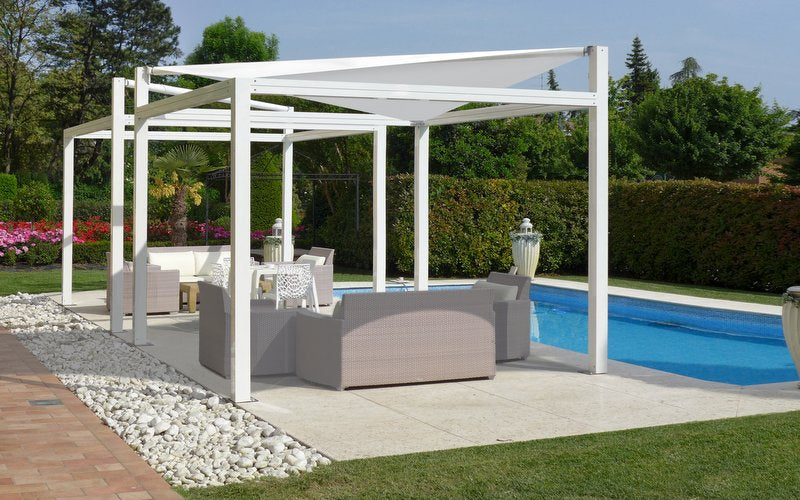The Ultimate Overview to Choosing the Right Shade Sails for Your Home
Choosing the excellent Shade sails for your home can seem difficult, offered the myriad of choices offered. From the plethora of materials like polyethylene, pvc, and polyester, to the wide variety of forms and colors, the decision-making process requires a mutual understanding of each variable's advantages and disadvantages. Beyond selection, efficient setup and upkeep are extremely important to the longevity and efficiency of your Shade sails. In the complying with areas, we will certainly lead you through these factors to consider, leading the way for a notified choice.
Recognizing the Basics: What Is a Shade Sail?

The idea of the Shade sail days back to ancient Egypt and Greece, where big items of fabric were utilized to secure people from the sunlight. This primitive concept has progressed into today's advanced layouts, which not only offer defense from sun and rain however also add visual worth to the surroundings.
Choosing the excellent Shade sail includes considering different factors such as size, shape, installment, and color requirements. While the product made use of is vital, it is equally vital to understand the fundamental principle and utility of a color sail prior to purchasing.
Discovering Different Shade Sail Materials and Their Advantages

Polyethylene, a light-weight, resilient material, is perfect for areas that call for high UV defense and warm resistance. It is also very easy to keep, making it a prominent choice amongst home owners.
Polyester, on the various other hand, is known for its supreme toughness and versatility. It's ideal for harsh environments, qualified of enduring strong winds and hefty rains without losing its form or color.
Lastly, PVC attracts attention for its water resistant buildings and high light transmission. This material allows all-natural light to filter through while giving shelter from rain, making it ideal for areas where both light and climate security are desired.
Choosing the Right Shade Sail Shape for Your Room
How does one pick the ideal Shade sail form for their area? The solution lies in recognizing the functional and visual implications of various forms. Rectangular or square Shade sails are typically preferred for their effectiveness in covering bigger areas. They give uniform Shade and are less complicated to install see it here because of their symmetrical type. Triangular Shade sails, with their unique visual appeal, can be overlapped and set up in numerous configurations to produce a visually fascinating cover. This makes them an attractive option for rooms where the aesthetic aspect is vital.
One need to additionally consider the wind problems in their location. Triangular sails, with less support points, tend to fare better in windy conditions compared to their square or rectangular counterparts. Choosing the right Shade sail shape is, as a result, an issue of stabilizing usefulness with aesthetic appeals, his response while taking into consideration the specific conditions of one's space.
Trick Factors To Consider When Picking Shade Sail Color Styles
The selection of shade for Shade sails is not only an aesthetic choice yet likewise one that can influence the ambiance of the room. Shade sail repairs. It is vital to think about elements such as the psychology of colors, just how the Shade matches with the home's existing looks, and the suitability of the color for the period. These factors to consider can help homeowners make educated decisions that enhance their exterior living areas
Installation Tips for Shade Sails: do it yourself vs. Specialist Aid
When the perfect Shade sail is picked, the next critical action is its installation. This elevates an essential inquiry: Should one attempt to establish it up themselves or employ the solutions of an expert? Both methods have their qualities and difficulties, which will be the focus of this conversation.
Preserving Your Shade Cruises: Cleaning and Fixing Tips
Preserving the visual appeal and practical integrity of your Shade sails calls for regular upkeep, consisting of cleaning and fixing. In time, direct exposure to the elements can cause dust accumulation, colour fading, and architectural damages.
For cleaning, a moderate cleaning agent and water mixture applied with a soft bristle brush can properly remove dust and mold. Rinse completely to protect against soap residue. Prevent rough chemicals that can damage the material and endanger the sail's UV defense.
In terms of repair work, small rips can be patched utilizing fixing kits offered from the supplier. However, major damages might call for professional intervention. It's essential to attend to problems without delay to prevent further degeneration.
Upkeep additionally expands to the sustaining frameworks. Examine frequently for indications of rust or weakening and attend to any type of problems promptly.
Via regular treatment and interest, your Shade sails can stay a practical and lovely enhancement to your home for many years to find.
Final thought
Choosing the right Shade sail considerably enhances your home's exterior allure. Key considerations consist of choosing resilient materials such as polyethylene, polyester, or PVC, selecting a design that enhances your area, and thinking about color influences. Installment can be a DIY project or professionally took care of, relying on complexity - Shade sail repairs. Routine maintenance, consisting of cleaning and repairs, makes sure the durability of your Shade sails, providing a satisfying outdoor living experience and a cosmetically pleasing home exterior.
A shade sail, as the name check my source suggests, is a tool developed to give outdoor Shade.Just how does one choose the ideal Shade sail form for their space? Picking the right Shade sail shape is, consequently, a matter of balancing usefulness with looks, while considering the particular problems of one's room.
Key Considerations When Picking Shade Sail Color Styles
Choosing the ideal Shade sail dramatically enhances your home's outside allure.
Comments on “Shade sails Broadbeach Waters for both residential and commercial properties”